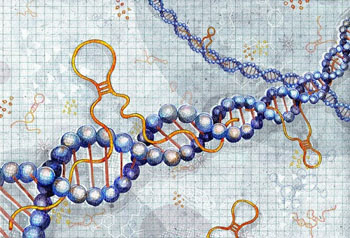Long Non-Coding RNAs Linked to Development and Progression of Prostate Cancer
By LabMedica International staff writers
Posted on 25 Aug 2016
Cancer researchers have found a link between a number of long non-coding RNAs and the development and progression of prostate cancer.Posted on 25 Aug 2016
Long non-coding RNAs (lncRNAs) are non-protein coding transcripts longer than 200 nucleotides. This somewhat arbitrary limit distinguishes lncRNAs from small regulatory RNAs such as microRNAs (miRNAs), short interfering RNAs (siRNAs), Piwi-interacting RNAs (piRNAs), small nucleolar RNAs (snoRNAs), and other short RNAs. LncRNAs have been found to be involved in numerous biological roles including imprinting, epigenetic gene regulation, cell cycle and apoptosis, and metastasis and prognosis in solid tumors. Most lncRNAs are expressed only in a few cells rather than whole tissues, or they are expressed at very low levels, making them difficult to study.

Image: An illustration of long non-coding RNAs (Photo courtesy of Julia Yellow).
Investigators at the University Health Network (Toronto, Canada) and the University of Toronto (Canada) combined integrative analysis of the lncRNA transcriptome with genomic data and SNP (single nucleotide polymorphism) data from prostate cancer genome-wide association studies (GWAS) to identify 45 candidate lncRNAs associated with risk of prostate cancer.
They reported in the August 15, 2016, online edition of the journal Nature Genetics that their top hit, the lncRNA PCAT1, promoted prostate cancer cell proliferation and tumor growth in vitro and in vivo.
"Non-coding RNA has many functions and in this study we found that PCAT1 functions as a kind of glue to attract different protein complexes together and guide them to specific genomic location to activate their target gene expression that starts the disease process," said senior author Dr. Housheng Hansen He, assistant professor of medical biophysics at the University of Toronto. "Cancer is very smart to take every possible way to survive and use every piece of our genome. If research only focuses on the 2% of the genome that is the protein- coding genes, we will have limited understanding of how the cancer can survive. We cannot achieve personalized cancer medicine without understanding the other 98% of our genome."
Related Links:
University Health Network
University of Toronto








 (3) (1).png)




